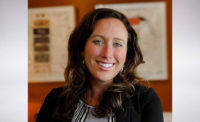Title: Director of Engineering, ADG|Blatt and Managing Partner at OKBeCo
Age: 37
Educational Experience: Bachelor’s degree in mechanical engineering, University of Oklahoma, associate’s degree in pre-engineering, Oklahoma City Community College
Professional Credentials/Accreditations: Professional engineer (P.E.) in Oklahoma and Texas
Organizational Affiliations/Achievements/Awards: ASHRAE member (2013-present), currently serving as chair of the Young Engineers in ASHRAE committee and past president of the Central Oklahoma chapter; director of the Oklahoma City Community College Association of Alumni and Friends, 2018 to present; and HeartLine board of directors, 2020 to present
What does your day-to-day job entail?
I work closely with architectural project managers to coordinate and review the engineering designs for all disciplines, both internal and consultants. Occasionally, I still fill the role of engineer of record for the right projects. Additionally, I am the engineering project manager for projects that are mostly engineering for both the architectural and engineering department and the program management group that offers the owner’s rep services. I spend most of my day at my desk or in meetings, helping team members collaborate, authoring contracts, and attending networking or client events, all sprinkled with fairly regular visits to job sites.
What caused you to/when did you fall in love with engineering?
I neared high school graduation with little idea of what career path I wanted to take. I knew I loved physics and calculus, and engineering sounded like a good fit. I am a first-generation college student, so I was unsure how to navigate the collegiate process. I started out at a community college, which was a great decision for me. I think I fell in love with mechanical engineering during thermodynamics, as it was the first class that really challenged me. I had to work hard for that "A," and I loved it. After earning my associate’s degree, I began working in the HVAC industry as a mechanical designer at a mechanical, electrical,a nd plumbing (MEP) firm and transferred to a university to complete my bachelor’s degree. I found my niche in HVAC and have spent my career there.
What has been the most rewarding/proudest aspect of your engineering career?
My favorite moments are walking into a completed space and seeing the occupants fully engaged in their work with a beautiful, functional building that was designed specifically for them to help support their goals. Whether the project is a school, for a nonprofit, or the U.S. military, I am delighted to be a small part in helping communities to thrive.
What challenges do women face in this profession? Can you give a personal example? Why aren’t there more women in engineering? How can we increase the number of women in engineering?
It’s still a good-old-boys club in a lot of places. People who identify as women know the phrase, “You have to be twice as good to get half the respect.” Being twice as good is exhausting. I don’t have any profound solutions. A person could spend his or her entire career dissecting the complexities of why there are so few women in engineering, positions of power, elected offices, etc., and why so many of us chose to leave it. There are a lot of smart folks working on ways to diversify the industry. I can help by educating myself on their research, fighting for equity, and helping others around me.
How many years have you been active in the engineering sector? What’s changed the most in that time? What’s changed the least?
I have been in the industry for more than 16 years. The biggest changes have revolved around advancing codes, especially involving energy conservation. When I started, the International Code Council (ICC) codes were still fairly new and not adopted in some of the jurisdictions where buildings were being designed. Now, those codes are more consistently enforced across the country. I’ve been pleased to see the progress of the International Energy Conservation Code (IECC) helping buildings be more sustainable and efficient.
The smallest change has been the number of people who identify as women working as mechanical engineers. People who identify as women make up more than 50% of the population. Yet, when I started in the industry, just under 7% were people who identify as women. Now, nearly two decades later, that number has barely increased. Current National Science Foundation (NSF) data shows that women make up only 8% of mechanical engineers.
What drives/motivates you every day?
I am passionate about creating spaces that empower people to pursue their passions. Whether it is designing literal spaces that spark creativity and learning or creating a work atmosphere that inspires my colleagues to achieve more, I feel most fulfilled when those around me are in a space that empowers them.
What remains on your engineering bucket list — what do you aspire to do that you haven’t accomplished yet?
I would like to design a net-zero, carbon-neutral building.
What’s one thing no one knows about you?
I’m an old soul. I write my own knit, crochet, and quilt patterns. On any given weekend, I can be found in my craft room creating something with a podcast or audiobook playing in the background and sunshine streaming in the windows.
List any mentors who’ve helped you succeed and describe precisely how they’ve shaped your success.
I was very fortunate to work for one of the most incredible engineers for the first half of my career. Jeni Fair not only helped me grow in the technical part of my job but has remained a sounding board and reliable source of support even after I left her employ. I know when I pick up the phone to call her for help, she will answer.
What advice do you have for prospective female engineers considering entering the field?
Just be you. Be your authentic self. Perhaps the authentic you is a person who uses she/her pronouns and wears pink dresses and is flamboyant and highly empathetic. Lean into that. Perhaps the authentic you doesn’t fit in the conventional feminine box, uses different pronouns, and presents or thinks differently than others. Lean into that. Lean into your strengths. Authenticity and diversity of thought are two of the most important things you can bring into a room. Find people with other skill sets to augment the places where you are not as strong. And, look around for others to magnify their voices and help them succeed. Look for the helpers. Be a helper. Be a mentor. Be kind. Be you.





